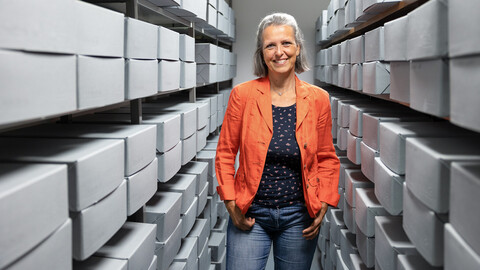A Visit to the Archives
In the University of Mannheim’s archives, over 800 meters of files are carefully conserved, cataloged, and prepared for research purposes. Alongside written materials, the underground archives also contain trophies, posters, and photographs that bear witness to bygone eras. Join us as we delve into the university’s history.

“Make sure to bring a sweater when you come to visit!” – as I descend into the basement of university building B6 27–29, I recall Dr. Sandra Eichfelder’s words. The head of the University Archives gives the same warning to all visitors. When you get down there, it is clear why: The archives are kept at a constant temperature of around 17 degrees Celsius, since temperature fluctuations are bad for the delicate paper. Behind six glass doors are the racks on which the archives’ treasures are safely stored in special boxes. “The boxes protect the documents from light, dust, and impacts. They also have an alkaline buffer solution that removes acid from the highly acidic paper from the 20th century and helps slow its deterioration,” explains Eichfelder, opening one of the doors.
As my gaze wanders over the ceiling-high racks, which are filled with carefully labelled boxes, she begins explaining the origins of the University Archives. Mannheim began keeping an archive back in 1967, when the former business college became a university. The archives were originally the responsibility of the President’s Office, until the Department of History took over in the early 2000s. They continued to be managed by nonspecialized staff until 2011, when the archives were professionalized and a qualified archivist brought in. “That was when I came on board, bounding with energy and enthusiasm,” recalls Eichfelder. During her second degree (in history), she worked as an student assistant at the archives. When the archivist post became free in 2014, she was, as she puts it, simply in the right place at the right time. That was almost ten years ago, but she has never become tired of the work.
“Sometimes I get a call out of the blue, for instance because a department is moving to a new location. Then I might need to spend half a day rooting through piles of boxes in a dusty cellar. It’s detective work that always throws up some surprises.” She has come across some real treasures and valuable historical sources in this way, explains the 55-year-old as she grabs a box from the racks. “Here, for example, is one of the most-requested documents – a staff questionnaire produced by psychology professor Otto Selz in 1933. All professors who were employed in the summer semester of that year were asked for personal details, in particular their religious denomination. Professor Selz himself honestly answered ‘Israelite,’” explains Eichfelder. Handwritten in black ink on thin, yellowing paper, the word takes on an ominous air given Selz’s eventual fate under the Nazi regime.
Popular items like this were digitized long ago, but researchers and students from all subjects are also warmly welcomed to visit the University Archives in person. “You can view the files and photograph or scan them. I’m a supporter of open archives. User-friendliness is a top priority.” Another priority is to ensure that the process of submitting items to the archives functions smoothly. Word has now spread throughout Mannheim that before anything that documents the history of teaching, research, and life at the university is thrown out, Eichfelder would love to take a look at it. There is no need to worry that personal details might be immediately published, as the University Archives are bound by strict rules on when that information can be released; files on procedural or administrative matters may only be published 30 years after the files are closed, and personal files ten years after the death of the individual concerned.
“Digitalization hasn’t reduced the amount of work archivists have to do,” grins Eichfelder, opening a door on the opposite side of the corridor to the room where the vast photo collection is stored. It contains more than 6,000 photos documenting the university’s history. “All these photos came to me in boxes or bags, which I could quickly sort through. When I receive a data storage device nowadays, by contrast, there are often 135 photos of the same event and I have to click on each one individually.” The deluge of data poses challenges for the archivist. As she works, her focus is squarely on the future: What will be of interest to future generations? “The best example is the Covid pandemic. I’ve collected all the circular emails and posters, because the pandemic will be a topic of future historical and sociological study.” There are also plans to use a website archiving tool.
At least 30 percent of Eichfelder’s time is currently being spent on a very special project that she is extremely passionate about: a book commemorating all the students and professors who were forced out during the Nazi period. She is working on the project with Professor Angela Borgstedt and other staff and students from the Department of History, with a lot of support from the President’s Office. The book is due to be published next year and will contain around 70 short biographies. “Although I’ve been managing the archives for a long time and am very familiar with their contents, during the in-depth research for this project I’ve constantly been surprised at the many and varied things we’ve found down here, which have allowed us to flesh out this chapter of the university’s history.” There is lots to discover and lots to do down here in the University Archives. For instance, Otto Selz’s handwritten notes are in a mix of shorthand and Sütterlin and have not yet been fully deciphered. And for anyone who is now tempted to pay a visit to the archives to do some research, a friendly bit of advice: Don’t forget to bring a sweater!
Text: Jule Leger/
